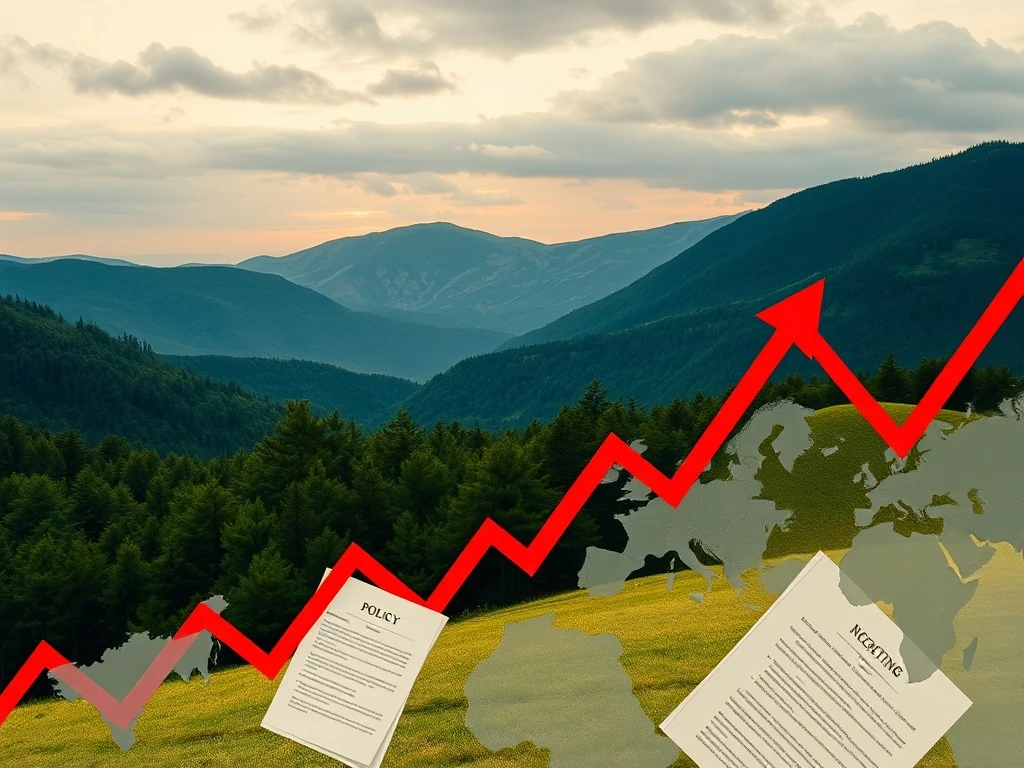The global economic landscape constantly evolves. Recent discussions highlight increased US market volatility. This raises questions about the factors shaping investor confidence and economic perceptions. Indeed, market participants closely monitor shifts in policy and global events. Therefore, understanding these dynamics is crucial for navigating modern financial markets. This article explores the various elements contributing to the perception of economic unpredictability. It also analyzes their impact on the stability of the US financial system.
Understanding US Market Volatility
US market volatility refers to the degree of variation of a trading price series over time. High volatility often signals uncertainty. Investors watch this metric carefully. Traditionally, developed economies like the United States exhibit lower volatility compared to emerging markets. However, recent periods have seen a shift in this perception. Consequently, analysts now frequently discuss the factors that contribute to this change. These factors include domestic policy decisions and international geopolitical events. Ultimately, market stability is a key indicator of economic health.
Many attributes define an ’emerging market.’ These often include:
- Higher political risk
- Greater policy unpredictability
- More susceptibility to external shocks
- Less developed financial and regulatory institutions
While the US maintains robust institutions, certain policy actions can introduce elements of uncertainty. This can lead to increased US market volatility. For example, sudden trade policy changes can disrupt global supply chains. Such disruptions directly affect corporate earnings. Moreover, they can dampen investor sentiment. Therefore, market participants demand clear and consistent communication from policymakers. This helps them make informed decisions.
Policy Shifts and Economic Predictability
Government policies play a pivotal role in shaping economic predictability. Significant shifts in fiscal, monetary, or trade policies can send ripples through markets. Consider, for instance, sudden changes in trade tariffs. These actions can trigger retaliatory measures from other nations. Consequently, this creates an environment of trade uncertainty. Businesses then face challenges in long-term planning. They may delay investments. This hesitancy can slow economic growth. Furthermore, it often contributes to increased US market volatility. Investors seek clarity and stability. They react negatively to unexpected policy announcements.
Regulatory changes also impact market sentiment. New regulations, or the repeal of existing ones, can alter operational costs for businesses. This affects their profitability. For example, changes in environmental or financial regulations can necessitate costly adjustments. Businesses must adapt quickly. This adaptability can be challenging. Hence, a consistent regulatory framework is vital for maintaining investor confidence. Predictable policy environments foster long-term investment. They reduce perceived risks. Therefore, policymakers strive for transparency and gradual implementation of changes. This approach helps to mitigate adverse market reactions.
Geopolitical Dynamics and Investor Confidence
Beyond domestic policy, global geopolitical dynamics significantly influence investor confidence. Tensions between major powers, regional conflicts, or even cyber warfare threats can heighten market anxiety. Investors often view such events as potential disruptions to global trade and stability. For example, sanctions imposed on one country can have spillover effects. These effects impact economies worldwide. This interconnectedness means that no market operates in isolation. Consequently, geopolitical developments can directly contribute to US market volatility.
International relations are increasingly complex. Diplomatic relations and alliances can shift rapidly. Such shifts create an unpredictable global environment. This unpredictability affects capital flows. Investors may move funds to perceived safe havens during periods of global instability. Conversely, positive diplomatic breakthroughs can boost confidence. They can encourage investment. Therefore, a stable international order is beneficial for all markets. It promotes global economic growth. Furthermore, it helps to reduce the likelihood of sharp market downturns. The perception of US leadership in global affairs also plays a role. It influences how investors view the country’s economic future.
Analyzing Key Economic Indicators Amidst Uncertainty
To assess US market volatility, analysts examine various economic indicators. These metrics provide objective insights into market health. Key indicators include:
- Currency Fluctuations: A strong, stable dollar often signals confidence. Rapid, unpredictable movements can indicate underlying stress.
- Bond Yields: Inverted yield curves, for instance, sometimes precede economic downturns. They reflect investor concerns about future growth.
- Equity Performance: Sharp, unexplainable swings in stock indices point to market unease. They reflect investor reactions to news and policy.
- Capital Flows: Sudden outflows of foreign investment can signal a loss of confidence. Inflows, conversely, indicate optimism.
These indicators provide a snapshot of market sentiment. They also show economic expectations. Analysts use them to identify trends. They can also spot potential risks. Therefore, monitoring these metrics is essential. It helps in understanding the broader economic picture. Moreover, it allows for more informed decision-making by investors. Consistent data analysis helps to separate temporary fluctuations from long-term trends.
Institutional Strength and Regulatory Frameworks
The strength of a nation’s institutions is a cornerstone of economic stability. Robust legal systems, independent central banks, and transparent regulatory bodies instill confidence. They provide a predictable environment for businesses and investors. In the US, institutions like the Federal Reserve and the Securities and Exchange Commission (SEC) play critical roles. They maintain financial stability. They also ensure market integrity. However, any perceived weakening of these institutions can introduce uncertainty. This contributes to US market volatility. For example, concerns about central bank independence can unnerve markets. Investors rely on these institutions for fair and consistent application of rules.
Regulatory frameworks are designed to protect investors and ensure fair competition. Changes to these frameworks must be carefully considered. They should aim to enhance, not diminish, market integrity. For instance, strong consumer protection laws foster trust. They encourage participation in financial markets. Conversely, a lack of clear regulations can deter investment. It can create an uneven playing field. Therefore, maintaining and strengthening these institutional pillars is paramount. It ensures sustained economic growth. It also helps to safeguard the financial system from undue shocks. A stable regulatory environment supports long-term planning and investment.
Global Economic Interdependence and its Impact
The global economy is deeply interconnected. Decisions made in one major economy can have significant ripple effects worldwide. The US economy, as the largest globally, holds particular influence. Its domestic policies, trade relations, and economic performance impact numerous countries. This interdependence means that global events can also feed back into the US market. For example, a recession in a major trading partner can reduce demand for US exports. This impacts US industries. Consequently, it can contribute to US market volatility.
International trade agreements, or their dissolution, also play a critical role. They shape global supply chains and market access. Changes can lead to uncertainty for multinational corporations. These corporations must then re-evaluate their strategies. Furthermore, global financial crises can quickly spread across borders. This highlights the need for international cooperation. Such cooperation helps manage economic challenges. Therefore, the US’s role in global economic governance is crucial. It helps to foster a more stable and predictable international environment. This benefits both domestic and international markets.
Mitigating Volatility: Fostering Economic Resilience
Fostering economic resilience is key to mitigating US market volatility. This involves several strategies. First, clear and consistent policy communication is essential. Policymakers should articulate their objectives. They should also explain their intended methods. This transparency helps reduce market speculation. Second, strengthening institutional safeguards is vital. This includes ensuring the independence of key economic bodies. It also means upholding the rule of law. Strong institutions provide a bedrock of stability. They protect against arbitrary decisions.
Furthermore, diversifying economic drivers helps. Reducing reliance on a single sector or industry can cushion against downturns. Investing in innovation and education also builds long-term strength. These investments enhance productivity. They also create new opportunities. Finally, international cooperation remains crucial. Collaborative efforts can address global challenges. These include climate change and pandemics. Such cooperation fosters a more stable global economic environment. Ultimately, a resilient economy is better equipped to absorb shocks. It can then recover more quickly. This benefits all stakeholders.
Conclusion
The perception of increased US market volatility stems from a complex interplay of factors. Policy shifts, geopolitical dynamics, and the interconnectedness of global economies all contribute. While the US maintains strong fundamental economic advantages and robust institutions, periods of uncertainty can arise. These periods challenge investor confidence. Understanding these contributing elements is vital for navigating modern financial markets. Ultimately, maintaining economic resilience requires transparent policy, strong institutions, and proactive engagement with global challenges. These efforts ensure the continued stability and attractiveness of the US economy for investors worldwide.
Frequently Asked Questions (FAQs)
1. What does ‘US market volatility’ mean?
US market volatility refers to the degree of price fluctuation in US financial markets over a specific period. High volatility means prices change rapidly and unpredictably, while low volatility indicates more stable prices. It is a key measure of market risk and uncertainty.
2. How do policy shifts contribute to market volatility?
Policy shifts, such as changes in trade tariffs, fiscal spending, or regulations, can introduce uncertainty for businesses and investors. Unexpected or frequent changes make it difficult for companies to plan, leading to investor apprehension and increased market fluctuations as participants react to new information.
3. What role do geopolitical events play in US market stability?
Geopolitical events, including international conflicts, diplomatic tensions, or global crises, can significantly impact investor confidence. These events can disrupt global trade, supply chains, and political stability, leading investors to seek safer assets and causing broader market unease, thus increasing volatility.
4. How can economic resilience mitigate market volatility?
Economic resilience involves a nation’s ability to withstand and recover from economic shocks. Strategies like clear policy communication, strong independent institutions, economic diversification, and international cooperation help build resilience. A resilient economy can absorb disruptions more effectively, reducing the severity and duration of market volatility.
5. Are there specific indicators to watch for US market volatility?
Yes, several indicators help track US market volatility. These include currency exchange rate fluctuations, changes in bond yields (especially the yield curve), equity market performance (e.g., the VIX index for stock market volatility), and patterns in international capital flows. Monitoring these metrics provides insights into market sentiment and potential risks.
6. Why is a neutral journalistic tone important when discussing market dynamics?
A neutral journalistic tone ensures that the analysis of market dynamics is objective and unbiased. It focuses on presenting facts, trends, and expert opinions without personal bias or political endorsement. This approach helps readers form their own conclusions and maintains the credibility and trustworthiness of the information provided.


















